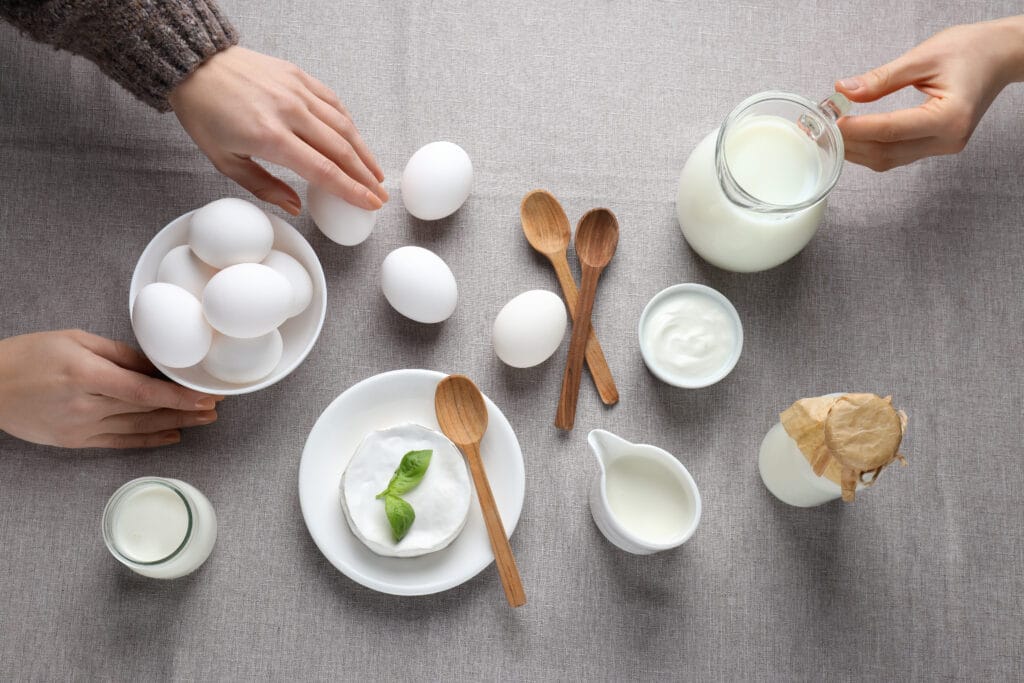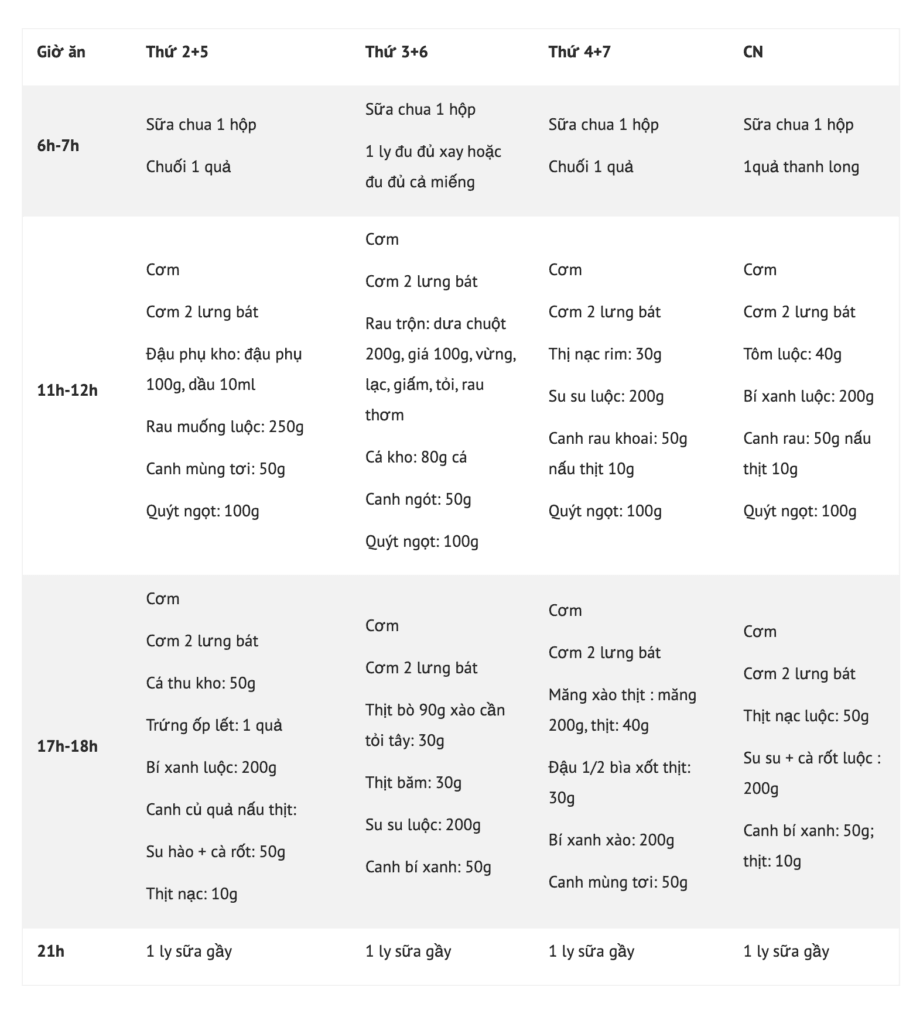Same topic
Topic “Bone and joint pain in the elderly” with you to learn the content.
Together to bring better healthcare solutions to the elderly.
-
Falls in the elderly
-
Weight loss regimen to prevent osteoarthritis?
-
Suitable diet for elderly with osteoporosis
-
Exercise regimen for people with osteoarthritis
-
How to take care of bones and joints for the elderly
-
Risk factors for osteoarthritis in the elderly
-
Weak Bones | Warning Signs and Diagnosis
-
Osteoarthritis, things not to be missed
-
Osteoporosis and what you need to know
-
Common musculoskeletal diseases
A proper diet is essential for everyone, especially those at risk or with osteoporosis who need to control their weight.
A normal adult needs to provide the body with 800 IU of vitamin D and 1,000 mg of calcium per day. However, the average Vietnamese diet only meets the body's calcium needs of 501 TP3T - This is also the main risk of osteoporosis.
The lack of calcium, vitamin D and other minerals affects the body, not having enough "raw materials" to regenerate and produce new tissue.
So, diet for sick people osteoporosis How? Let's find out the details with Hio!

Note: This article is for reference only. Please consult a nutritionist for appropriate dietary advice.
Foods to supplement for strong bones
Milk and dairy products
Milk is one of the leading sources of calcium, with calcium content up to 60%. Therefore, milk and dairy products (yogurt, cheese…) are very good foods for people with osteoporosis.
Seafood
Seafood is a rich source of calcium and protein such as shrimp, crab, etc. To help the body absorb more calcium, Seafood should be cooked thoroughly and well done. However, people who have both osteoporosis and gout condition then eliminate this diet.
Foods derived from eggs
Eggs (chicken eggs, duck eggs, bird eggs...) are a rich source of minerals such as calcium, selenium, vitamins, folate, protein...
You can change the way you cook eggs such as: boiled, fried, scrambled, stewed, etc. to enrich your diet. Although eggs are very good for people with osteoporosis, patients should only eat 2-3 eggs/time, 2-3 times a week.

Vegetables and fruits
Vegetables that are good for bones include: broccoli, kale, soybeans, cabbage...
Not only are vegetables and fruits beneficial for osteoporosis, they are also good for your health.
Processing by boiling to be able to absorb as much calcium and vitamin D as possible from this food group.
In addition to vegetables and fruits, fruit juice is also a rich source of nutrients for people with osteoporosis. Banana and orange juice are great choices for people with osteoporosis because of their high calcium and vitamin D content. In addition to drinking enough water, patients can drink 1-2 glasses of juice per day.
Cereal
Not only do they contain high levels of vitamin D and calcium, but some cereals made from whole wheat are also very good for your health. Osteoporosis patients, especially those aged 40 and over, should eat cereals every day to supplement calcium for the body. However, it is important to choose cereals with low sugar content to avoid hyperglycemia, especially in diabetic patients.
Foods rich in Omega 3
Not only beneficial for people with osteoporosis, Omega-3 also provides great support for other bone and joint diseases such as herniated discs, spinal degeneration...
Foods rich in Omega-3 include sardines, salmon, mackerel, etc. To absorb the most omega-3 and calcium, these fish need to be cooked until soft enough to eat the bones. In addition, omega can also be supplemented through functional foods and fish oil.
What foods should people with osteoporosis avoid?
In addition to supplementing foods with nutrients that are good for bones and joints, patients also need to pay attention to foods to avoid. (3)
1. Meat and protein-rich foods
Bones contain about 50% of protein. The process of “reinforcing” bones requires a steady supply of amino acids. Meanwhile, amino acids are important components to make up proteins, so people with osteoporosis should still eat foods containing protein. However, it is important to note that the source of protein should be changed from red meat to white meat (chicken, fish, etc.) and that protein consumption should be moderate. Excess protein will lead to increased calcium excretion in urine.
2. Salty foods
Sodium in table salt causes calcium loss and weakens bones over time. Therefore, people with osteoporosis should try to limit their intake of salty foods such as:
- Processed meats: ham, sausage, canned meat…
- Fast food: fried chicken, pizza, french fries…
- Dried meats: beef jerky, squid jerky, chicken jerky...
- Fish sauce, fish sauce…
Additionally, to determine whether a food is high in sodium, patients can look at the % daily value in the nutrition panel on the product packaging. If the sodium index is higher than 20%, the dish is high in salt.
3. Spinach and foods containing oxalate
Spinach, beets, and some beans are high in oxalates. Oxalates prevent the body from absorbing calcium, so people with osteoporosis should avoid these foods.
4. Wheat bran
Wheat bran is the outer layer of the wheat kernel, separated from the milling process, and is very nutritious. However, the high phytate content in wheat bran can prevent the body from absorbing calcium. If you take calcium supplements, you should take them at least 2 hours before or after eating wheat bran.
5. Beverages
- Some soft drinks and carbonated drinks contain phosphoric acid, which increases calcium excretion in urine.
- Caffeine in coffee and tea will leach calcium from bones and reduce calcium absorption, thereby losing bone structure.
- Heavy alcohol consumption leads to increased urinary calcium excretion.
1 week menu for people with osteoporosis
Summary suggestions presented by Head of Nutrition Department – Vietnam Friendship Hospital – Cuba Dong Hoi – Note: the menu is for reference only.
- Energy: 1400-1500Kcal
- Protid: 20%
- Lipids: 15%
- Carbohydrates: 65%

Are you looking for home or facility-based care?
Hio is a pioneering platform providing comprehensive and personalized elderly care services at home and medical facilities. No additional costs, change caregivers without additional costs, immediate refund if customers are not satisfied, care information is continuously updated to ensure peace of mind for families.





